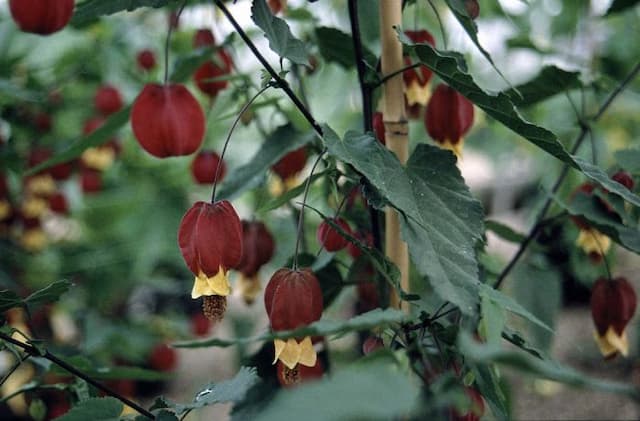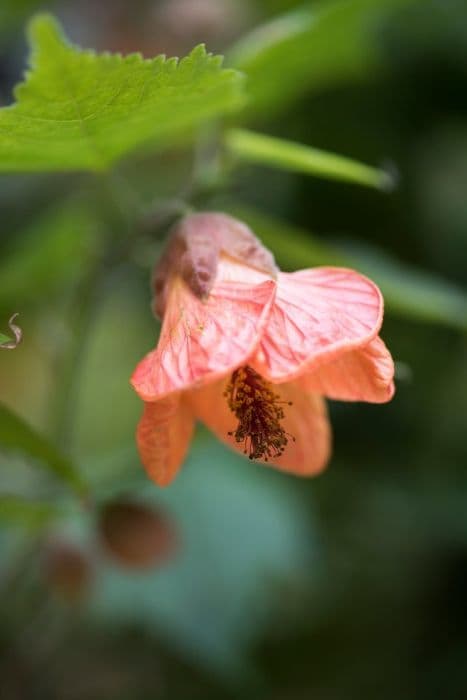Tree mallow Lavatera thuringiaca

ABOUT
The plant known as Lavatera thuringiaca, commonly referred to as the tree mallow, has a robust and bushy appearance with a somewhat woody base. Its stems are covered with fine hairs which give them a soft texture. The leaves are notable for their heart-shaped form with a somewhat lobed edge, and they hold a deep green color with a slightly coarse texture. Flowering generously throughout the summer months, tree mallow boasts large, funnel-shaped blossoms which come in a beautiful range of colors from white to pink, often with striking veins of a darker hue radiating from the throat of the flower to the edges of the petal, which can be slightly crinkled at their margins. The centers of the blooms often have a blush of darker coloration, encircling the prominent column of fused stamens and pistils, which is a characteristic feature of this plant. The overall effect of the tree mallow in bloom is one of a lush, soft-textured plant adorned with a profusion of showy flowers that create spots of bright color, attracting various pollinators. Its foliage and blossoms together make the tree mallow prized for its ornamental value in gardens where it offers a striking display that enlivens the landscape.
About this plant
 Names
NamesFamily
Malvaceae.
Synonyms
Thuringian Mallow, Garden Tree-Mallow, Common Tree Mallow.
Common names
Lavatera thuringiaca.
 Toxicity
ToxicityTo humans
Tree mallow (Lavatera thuringiaca) is generally not considered toxic to humans. There is little information suggesting that the plant poses a risk when touched or ingested. As with any plant, some individuals may experience allergic reactions or skin irritation upon contact with its sap or foliage, and it is not recommended for consumption since it is not a food crop. However, there are no widely recognized symptoms of poisoning from the tree mallow for humans because it's not commonly associated with toxicity.
To pets
Tree mallow (Lavatera thuringiaca) is not widely known to be toxic to pets. There is limited information on its effects if ingested by animals, but it is not typically listed as a hazardous plant to domestic pets such as dogs and cats. While it is always best to prevent pets from eating ornamental plants as some may cause gastrointestinal upset, there are no specific symptoms of poisoning associated with the tree mallow for pets. As with any non-food plant, pets should be monitored for any signs of distress if they consume parts of the tree mallow, and you should consult with a veterinarian if such a situation arises.
 Characteristics
CharacteristicsLife cycle
Perennials
Foliage type
Deciduous
Color of leaves
Green
Flower color
Pink
Height
6 feet (1.8 meters)
Spread
4 feet (1.2 meters)
Plant type
Shrub
Hardiness zones
6
Native area
Europe
Benefits
 General Benefits
General Benefits- Attracts Wildlife: Lavatera thuringiaca, commonly known as the Garden Tree Mallow, is known for attracting bees, butterflies, and other beneficial insects to the garden, enhancing pollination of surrounding plants.
- Ornamental Value: The Garden Tree Mallow boasts showy flowers that add aesthetic beauty to any landscape, making it a popular choice for gardeners seeking to enhance visual interest.
- Drought Resistance: Once established, this plant is relatively drought-tolerant, making it a good choice for xeriscaping and gardens in arid climates.
- Low Maintenance: The Garden Tree Mallow generally requires minimal care, thus saving time and effort for individuals who wish for a beautiful garden without extensive upkeep.
- Rapid Growth: This species is known for its fast growth rate, which can quickly provide coverage, privacy, or fill in bare spots in the garden.
- Soil Adaptability: It is adaptable to a wide range of soil conditions, from poor to fertile, which makes it versatile for different landscape settings.
 Medical Properties
Medical Properties- Anti-inflammatory: Lavatera thuringiaca may possess anti-inflammatory properties that can help in reducing inflammation.
- Antiseptic: The plant may have antiseptic qualities that can assist in preventing the growth of microorganisms.
- Demulcent: The mucilaginous substances found in the plant can soothe and protect irritated or inflamed internal tissues.
- Diuretic: This property promotes the increase of urine production, which can help in detoxifying the body.
- Emollient: The plant may have soothing effects on the skin, making it useful in treating external irritations.
- Laxative: Some parts of the plant are believed to have a mild laxative effect which can aid in bowel movements.
- Vulnerary: Lavatera thuringiaca may promote the healing of wounds when applied topically.
 Air-purifying Qualities
Air-purifying QualitiesThis plant is not specifically known for air purifying qualities.
 Other Uses
Other Uses- Lavatera thuringiaca, commonly known as the garden tree-mallow, can be used as a natural dye, providing a range of subtle colors for fabrics and yarns.
- The fibrous stems of garden tree-mallow can be useful in making paper or as a component in composite materials for lightweight constructions.
- Due to its rapid growth, garden tree-mallow can serve as a temporary privacy screen or windbreak in gardens and on terraces.
- The flowers of the garden tree-mallow are edible and can be used to add a colorful garnish to salads or desserts.
- In some countries, the leaves of garden tree-mallow have been used as a substitute for tobacco in smoking blends.
- Garden tree-mallow can be used in companion planting to attract beneficial insects that help control pests in the garden.
- The plant's seed fluff can be gathered and used as a filling material for small pillows or as tinder for starting fires.
- Garden tree-mallow has been utilized as a natural insulating material in eco-friendly home building projects.
- The mucilaginous texture of garden tree-mallow leaves can be used as a thickening agent in soups and stews.
- Due to its ornamental appearance, garden tree-mallow can be grown as a living support structure for climbing plants in garden designs.
Interesting Facts
 Feng Shui
Feng ShuiThe Lavatera is not used in Feng Shui practice.
 Zodiac Sign Compitability
Zodiac Sign CompitabilityThe Lavatera is not used in astrology practice.
 Plant Symbolism
Plant Symbolism- Resilience: Lavatera thuringiaca, commonly known as the tree mallow, often grows in harsh environments, symbolizing the ability to endure and thrive in difficult conditions.
- Healing: Historically, parts of the tree mallow have been used in traditional medicine, which symbolizes healing and the alleviation of suffering.
- Breathability: The tree mallow's large, open blooms can symbolize the importance of breathing or taking a moment to relax and enjoy life's simple pleasures.
- Femininity: With its delicate flowers, the tree mallow can represent softness, grace, and beauty, often associated with femininity.
- Generosity: The plant's propensity to produce a profusion of flowers has been interpreted as a symbol of abundance and generosity.
 Water
WaterTree mallows prefer consistent moisture, particularly during dry spells. Water thoroughly to ensure the water reaches the plant's deep roots, soaking the soil to promote healthier growth. During the growing season, a weekly watering of approximately 1 to 1.5 gallons should suffice, depending on rainfall. However, once established, tree mallows can tolerate some drought. In hotter climates, check the soil moisture regularly and water if the top inch of soil feels dry to the touch.
 Light
LightTree mallows thrive best in full sun conditions where they can receive at least six to eight hours of direct sunlight daily. They should be planted in a spot that provides ample sunlight without shade from buildings or larger plants to optimize their growth and ensure vibrant blooms.
 Temperature
TemperatureTree mallows are hardy and can tolerate a range of temperatures but perform best in conditions between 50°F and 85°F. They can survive minimal winter temperatures of around 20°F, but to ensure they live through colder winters, providing some form of frost protection is helpful. The ideal temperature range promotes healthy growth and flowering.
 Pruning
PruningTree mallows should be pruned in late winter or early spring to remove any dead or damaged branches and to maintain a desirable shape. Pruning also encourages new growth and, subsequently, more flowers. Typically, pruning once a year is sufficient unless additional shaping is required during the growing season.
 Cleaning
CleaningAs needed
 Soil
SoilTree mallow (Lavatera thuringiaca) thrives best in well-draining soil enriched with organic matter, such as compost or well-rotted manure. A soil pH ranging from neutral to slightly alkaline (pH 6.0-7.5) is ideal for this plant. For an optimal soil mix, combine two parts garden soil, one part compost, and one part perlite or sand to ensure drainage.
 Repotting
RepottingTree mallow (Lavatera thuringiaca) does not typically require frequent repotting as it is a perennial plant. It can be repotted every 2 to 3 years to refresh the soil or if it has outgrown its current container. When repotting, select a container only slightly larger than the previous one.
 Humidity & Misting
Humidity & MistingTree mallow (Lavatera thuringiaca) is tolerant of a range of humidity levels and does not require high humidity to thrive. It can successfully grow in the average outdoor humidity levels found in its hardiness zones. Indoor growing may require some additional humidity during dry winter months.
 Suitable locations
Suitable locationsIndoor
Place tree mallow in a bright spot, avoiding direct strong sun.
Outdoor
Plant tree mallow in full sun, sheltered from strong winds.
Hardiness zone
6-9 USDA
 Life cycle
Life cycleLavatera thuringiaca, commonly known as the tree mallow, begins its life cycle as a seed which germinates in spring after winter stratification to break dormancy. Seedlings grow rapidly in favorable conditions of sunlight and well-drained soil, developing into sturdy plants with large, heart-shaped leaves. The tree mallow enters a vigorous vegetative growth phase, during which it develops a strong, often woody, stem and branches. By mid to late summer, it reaches the flowering stage, producing conspicuous, funnel-shaped flowers that are often pink or light purple, attracting pollinators like bees and butterflies. After pollination, the plant sets seed within round, cheese-shaped capsules that ripen and eventually open to release seeds for dispersal. The plant can act as a perennial, surviving through the winter in milder climates, or behave as a biennial or short-lived perennial, dying after seed set, thereby completing its life cycle.
 Propogation
PropogationPropogation time
Spring-Early Summer
The most popular method of propagating Lavatera thuringiaca, commonly known as the Tree Mallow, is through seed sowing. Seeds can be sown in late winter to early spring under cover, in individual pots of well-drained soil. It's important to maintain a temperature of around 60-70°F (15-21°C) for optimal germination. Once the seedlings have developed their first true leaves, they can be transplanted into larger containers or direct into the garden after all risk of frost has passed and they have been properly acclimatized to outdoor conditions. Seed propagation allows for a high volume of new plants and maintains the varietal characteristics of the parent plant when seeds are collected from non-hybrid varieties.









